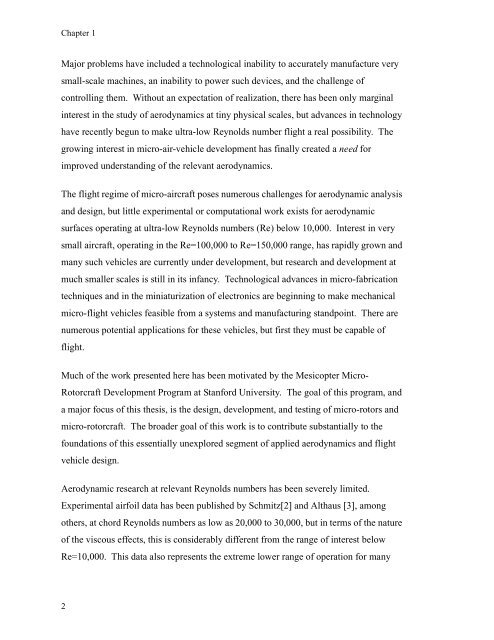Aerodynamics and Design for Ultra-Low Reynolds Number Flight
Aerodynamics and Design for Ultra-Low Reynolds Number Flight
Aerodynamics and Design for Ultra-Low Reynolds Number Flight
Create successful ePaper yourself
Turn your PDF publications into a flip-book with our unique Google optimized e-Paper software.
Chapter 1<br />
Major problems have included a technological inability to accurately manufacture very<br />
small-scale machines, an inability to power such devices, <strong>and</strong> the challenge of<br />
controlling them. Without an expectation of realization, there has been only marginal<br />
interest in the study of aerodynamics at tiny physical scales, but advances in technology<br />
have recently begun to make ultra-low <strong>Reynolds</strong> number flight a real possibility. The<br />
growing interest in micro-air-vehicle development has finally created a need <strong>for</strong><br />
improved underst<strong>and</strong>ing of the relevant aerodynamics.<br />
The flight regime of micro-aircraft poses numerous challenges <strong>for</strong> aerodynamic analysis<br />
<strong>and</strong> design, but little experimental or computational work exists <strong>for</strong> aerodynamic<br />
surfaces operating at ultra-low <strong>Reynolds</strong> numbers (Re) below 10,000. Interest in very<br />
small aircraft, operating in the Re=100,000 to Re=150,000 range, has rapidly grown <strong>and</strong><br />
many such vehicles are currently under development, but research <strong>and</strong> development at<br />
much smaller scales is still in its infancy. Technological advances in micro-fabrication<br />
techniques <strong>and</strong> in the miniaturization of electronics are beginning to make mechanical<br />
micro-flight vehicles feasible from a systems <strong>and</strong> manufacturing st<strong>and</strong>point. There are<br />
numerous potential applications <strong>for</strong> these vehicles, but first they must be capable of<br />
flight.<br />
Much of the work presented here has been motivated by the Mesicopter Micro-<br />
Rotorcraft Development Program at Stan<strong>for</strong>d University. The goal of this program, <strong>and</strong><br />
a major focus of this thesis, is the design, development, <strong>and</strong> testing of micro-rotors <strong>and</strong><br />
micro-rotorcraft. The broader goal of this work is to contribute substantially to the<br />
foundations of this essentially unexplored segment of applied aerodynamics <strong>and</strong> flight<br />
vehicle design.<br />
Aerodynamic research at relevant <strong>Reynolds</strong> numbers has been severely limited.<br />
Experimental airfoil data has been published by Schmitz[2] <strong>and</strong> Althaus [3], among<br />
others, at chord <strong>Reynolds</strong> numbers as low as 20,000 to 30,000, but in terms of the nature<br />
of the viscous effects, this is considerably different from the range of interest below<br />
Re=10,000. This data also represents the extreme lower range of operation <strong>for</strong> many<br />
2




